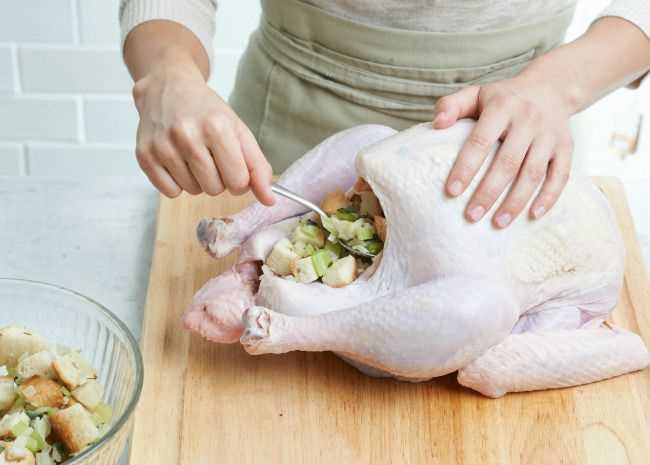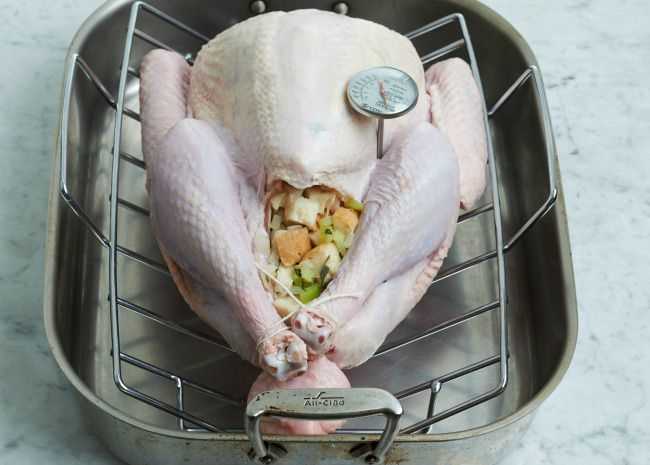







Stuffing, also known as dressing depending on where you’re from, is a traditional accompaniment to roast turkey. It adds moisture, flavor, and texture to the meat, making it a beloved part of holiday feasts. But do you stuff the turkey before cooking it? The answer can vary depending on who you ask.
Traditionally, stuffing the turkey is the way to go. As the turkey cooks, the juices from the meat mix with the stuffing, creating a delicious blend of flavors. The stuffing absorbs the turkey’s natural juices, becoming moist and flavorful. It’s a classic technique that has been passed down through generations.
However, there are some concerns to consider when stuffing the turkey. One of the main concerns is food safety. If the stuffing does not reach a safe internal temperature, it can harbor harmful bacteria like Salmonella. To ensure food safety, it’s important to stuff the turkey just before roasting and make sure the stuffing reaches an internal temperature of 165°F (74°C).
Another option is not to stuff the turkey and instead cook the stuffing separately in a casserole dish. This eliminates the risk of undercooked stuffing and allows it to develop a crispy top. Plus, cooking the stuffing separately can save cooking time as the turkey will cook faster without the additional weight of the stuffing.
In conclusion, whether you stuff the turkey before cooking or cook the stuffing separately is a matter of personal preference and food safety considerations. Both methods have their advantages and disadvantages, so choose the one that suits your taste and circumstances best. Just be sure to follow proper food safety guidelines to ensure a delicious and safe holiday meal!
Preparing the Turkey
Preparing the turkey is an essential step in creating a delicious and flavorful Thanksgiving meal. Whether you stuff the turkey before cooking or not is a personal preference, but it is important to take certain steps to ensure the turkey is cooked safely and to perfection.
Step 1: Thawing the Turkey
Before preparing the turkey, make sure it is completely thawed. Thawing the turkey in the refrigerator is the safest method, allowing the turkey to defrost slowly. It is recommended to allow 24 hours of thawing time for every 4-5 pounds of turkey.
Step 2: Cleaning the Turkey
Once the turkey is thawed, remove the giblets and neck from the turkey cavity. Rinse the turkey inside and out with cold water, and pat it dry with paper towels. Cleaning the turkey helps to remove any bacteria and ensures a clean and safe cooking process.
Step 3: Seasoning the Turkey
Seasoning the turkey is an important step in enhancing its flavor. You can choose to stuff the turkey with a stuffing mixture before cooking, or you can season the turkey by rubbing it with a mixture of herbs, spices, and oil. Whether you stuff the turkey or not, make sure to season both the inside and outside of the turkey.
Note: If you choose to stuff the turkey, make sure the stuffing is cooked to a minimum internal temperature of 165°F (74°C) to ensure it is safe to eat.
Step 4: Cooking the Turkey
There are several methods for cooking the turkey, including roasting, grilling, or deep-frying. Make sure to follow the recommended cooking times and temperatures for your chosen cooking method. It is important to cook the turkey thoroughly to ensure it reaches a safe internal temperature of 165°F (74°C).
Remember: It is best to use a meat thermometer to check the internal temperature of the turkey for accuracy.
Following these steps will help you prepare a delicious and juicy turkey for your Thanksgiving feast. Whether you choose to stuff the turkey or not, make sure to take the necessary precautions to ensure a safe and enjoyable meal.
Cleaning and Patting Dry
Before stuffing the turkey, it is important to clean it thoroughly to remove any bacteria or contaminants that may be present on the surface. Begin by rinsing the turkey inside and out with cold water. Use your hands to gently rub the skin, removing any dirt or debris that may be present.
After rinsing, pat the turkey dry using paper towels or a clean kitchen towel. It is essential to remove as much moisture as possible to ensure that the stuffing will cook evenly and the skin will become crispy during roasting. Take care to dry both the interior and exterior of the turkey, paying special attention to any crevices or folds of skin where moisture may collect.
Removing Giblets and Neck
Before proceeding with stuffing or further preparation, be sure to remove the giblets and neck from the turkey cavity. These can be used to make gravy or discarded, depending on your recipe. They are typically found in a small package inside the bird, so be sure to check both cavities.
Sanitizing Surfaces
After handling raw poultry, it is crucial to sanitize all surfaces and utensils that came into contact with the turkey to prevent cross-contamination. Wash cutting boards, knives, and countertops with hot, soapy water, and rinse thoroughly. You can also use a solution of one tablespoon of bleach per gallon of water for additional disinfection.
By following these steps to clean and pat dry your turkey, you can ensure a safe and delicious holiday meal.
Seasoning the Turkey

Seasoning the turkey is an essential step in creating a flavorful and delicious roast. The right combination of herbs and spices can elevate the taste of the meat, making it juicy and mouthwatering.
Ingredients:
| 1 turkey | 2 tablespoons of salt |
| 1 tablespoon of black pepper | 2 teaspoons of garlic powder |
| 2 teaspoons of dried thyme | 1 teaspoon of dried rosemary |
| 1 teaspoon of paprika | 1/2 teaspoon of dried sage |
Instructions:
1. Rinse the turkey and pat it dry with paper towels.
2. In a small bowl, mix all the ingredients together to create a seasoning blend.
3. Rub the seasoning blend all over the turkey, making sure to cover both the inside and outside of the bird.
4. If desired, you can also gently separate the skin from the meat and rub some seasoning directly on the meat.
5. Once seasoned, cover the turkey and refrigerate it for at least 4 hours, or overnight if possible. This will allow the flavors to penetrate the meat.
6. Bring the turkey to room temperature before cooking.
7. Proceed with your preferred cooking method, whether it’s roasting, grilling, or smoking the turkey.
With the right combination of herbs and spices, seasoning the turkey will result in a tender and flavorful centerpiece for your holiday feast.
Trussing the Turkey

Trussing the turkey is an important step in preparing a delicious and evenly cooked bird. Trussing involves tying the turkey’s legs together and securing the wings to its body. This helps the turkey to cook more evenly and prevents the limbs from drying out.
Why truss the turkey?
Trussing the turkey helps to maintain its shape during cooking, which results in a more attractive presentation when it is served. By tying the legs together, the turkey’s breast is pushed forward, promoting more even cooking. Additionally, trussing prevents the wings from spreading out and drying out, and it also helps to keep the stuffing inside the turkey.
How to truss a turkey
To truss a turkey, start by tucking the wings behind the turkey’s back. This can be done by bending the wing tips backward and tucking them under the bird. Next, take a long piece of cooking twine and place it under the turkey’s legs, close to the body. Cross the twine over the legs and around the back of the bird. Pull the twine tight to secure the legs together. Finally, tie a knot to secure the twine.
Trussing the turkey should be done just before cooking. It is important to use twine that is oven-safe and resistant to melting. Care should also be taken not to tie the twine too tightly as this can affect the turkey’s cooking time.
Cooking the Turkey
When it comes to cooking the turkey, there are a few important steps to follow to ensure a delicious and succulent meat.
First, it is essential to properly thaw the turkey. This can be done by placing the frozen turkey in the refrigerator for several days. Make sure to calculate the thawing time based on the weight of the bird.
Before cooking the turkey, it is important to season it. This can be done by rubbing a mixture of salt, pepper, and herbs on the outside of the turkey. You can also stuff the cavity of the bird with a flavorful stuffing, if desired.
Next, preheat the oven to the recommended temperature, usually around 325°F (165°C). Place the turkey on a rack in a roasting pan and cover it loosely with aluminum foil. This will help to keep the turkey juicy and prevent it from drying out.
The cooking time will depend on the weight of the turkey. As a general rule, the turkey should cook for about 13 minutes per pound (28 minutes per kg). However, it is important to use a meat thermometer to check the internal temperature of the turkey. The turkey is ready when the thermometer inserted into the thickest part of the thigh reaches 165°F (74°C).
Once the turkey is cooked, allow it to rest for at least 20 minutes before carving. This will allow the juices to redistribute and result in a more flavorful and moist meat.
Overall, cooking the turkey requires some preparation and attention to detail, but the end result is definitely worth it. Follow these steps and enjoy a delicious Thanksgiving feast!
Questions and answers
Should I stuff the turkey before cooking it?
Yes, it is a common practice to stuff the turkey before cooking it. Stuffing adds flavor and moisture to the meat.
What are the benefits of stuffing the turkey?
Stuffing the turkey helps to keep the meat moist during cooking, as the stuffing absorbs the juices released by the bird. It also adds flavor to the meat.
Can I cook the stuffing separately from the turkey?
Yes, you can cook the stuffing separately from the turkey if you prefer. This can be a good option if you want to ensure the turkey cooks evenly or if you have dietary restrictions.
What should I consider when stuffing a turkey?
When stuffing a turkey, it is important to make sure the stuffing is cooked to a safe internal temperature of 165°F (74°C) to prevent the risk of foodborne illness. It is also important to stuff the turkey just before cooking, as stuffing it too far in advance can increase the risk of bacterial growth.
Are there any alternatives to traditional stuffing for turkey?
Yes, there are many alternative stuffing options for turkey, such as rice pilaf, quinoa, or bread stuffing with different herbs and spices. You can get creative and experiment with different flavors to find a stuffing that suits your taste.








